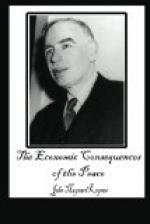[3] Including Poland and Finland, but excluding Siberia, Central Asia, and the Caucasus.
[4] Sums of money mentioned in this book in terms of dollars have been converted from pounds sterling at the rate of $5 to L1.
[5] Even since 1914 the population of the United States has increased by seven or eight millions. As their annual consumption of wheat per head is not less than 6 bushels, the pre-war scale of production in the United States would only show a substantial surplus over present domestic requirements in about one year out of five. We have been saved for the moment by the great harvests of 1918 and 1919, which have been called forth by Mr. Hoover’s guaranteed price. But the United States can hardly be expected to continue indefinitely to raise by a substantial figure the cost of living in its own country, in order to provide wheat for a Europe which cannot pay for it.
CHAPTER III
THE CONFERENCE
In Chapters IV. and V. I shall study in some detail the economic and financial provisions of the Treaty of Peace with Germany. But it will be easier to appreciate the true origin of many of these terms if we examine here some of the personal factors which influenced their preparation. In attempting this task, I touch, inevitably, questions of motive, on which spectators are liable to error and are not entitled to take on themselves the responsibilities of final judgment. Yet, if I seem in this chapter to assume sometimes the liberties which are habitual to historians, but which, in spite of the greater knowledge with which we speak, we generally hesitate to assume towards contemporaries, let the reader excuse me when he remembers how greatly, if it is to understand its destiny, the world needs light, even if it is partial and uncertain, on the complex struggle of human will and purpose, not yet finished, which, concentrated in the persons of four individuals in a manner never paralleled, made them, in the first months of 1919, the microcosm of mankind.
In those parts of the Treaty with which I am here concerned, the lead was taken by the French, in the sense that it was generally they who made in the first instance the most definite and the most extreme proposals. This was partly a matter of tactics. When the final result is expected to be a compromise, it is often prudent to start from an extreme position; and the French anticipated at the outset—like most other persons—a double process of compromise, first of all to suit the ideas of their allies and associates, and secondly in the course of the Peace Conference proper with the Germans themselves. These tactics were justified by the event. Clemenceau gained a reputation for moderation with his colleagues in Council by sometimes throwing over with an air of intellectual impartiality the more extreme proposals of his ministers; and much went through where the American and British critics were naturally a little




